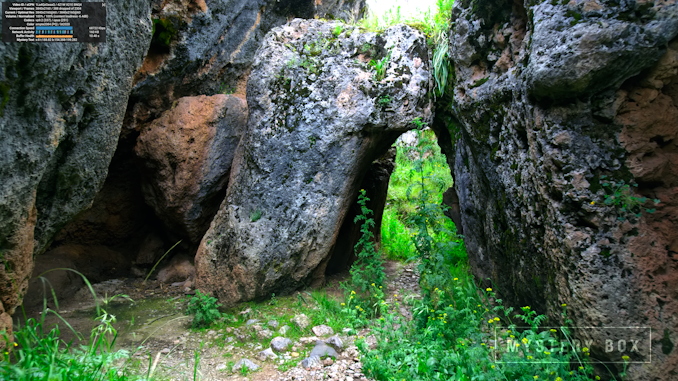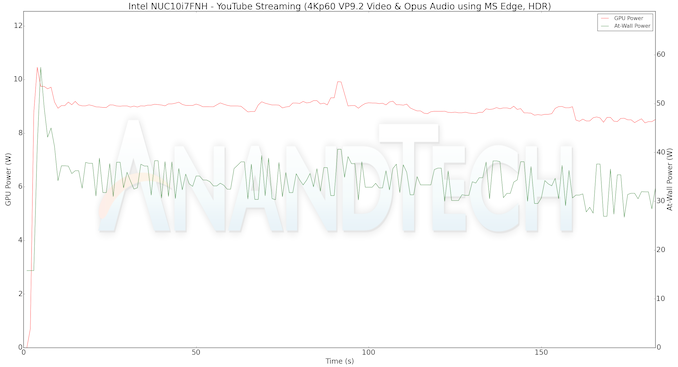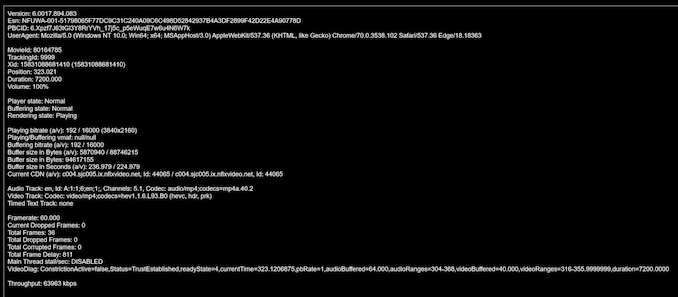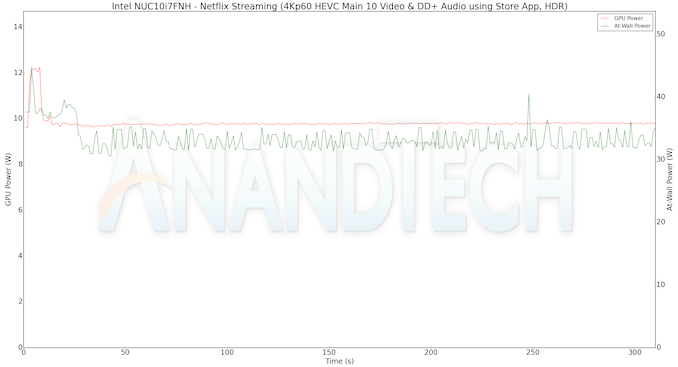Intel NUC10i7FNH Frost Canyon Review: Hexa-Core NUC Delivers a Mixed Bag
by Ganesh T S on March 2, 2020 9:00 AM ESTHTPC Credentials - YouTube and Netflix Streaming
The move to 4K, and the need to evaluate HDR support have made us choose Mystery Box's Peru 8K HDR 60FPS video as our test sample for YouTube playback. On PCs running Windows, it is recommended that HDR streaming videos be viewed using the Microsoft Edge browser after putting the desktop in HDR mode.
Similar to the last few NUC generations, the Frost Canyon NUC also has no trouble in hardware-accelerated playback of the VP9 Profile 2 video. Thankfully, AV1 (which is not hardware-accelerated yet) streams are not being delivered yet to the PC platform.
The 'new' GPU is not yet recognized by tools such as GPU-Z, and the media engine loading is not being correctly tracked by the various tools we usually use. Hence, we have only GPU power and at-wall power being reocrded for the media playback tests. The numbers for YouTube video playback are graphed below.
YouTube playback results in the GPU consuming around 9W of power on an average, with the at-wall consumption being around 35W.
The Netflix 4K HDR capability works with native Windows Store app as well as the Microsoft Edge browser. We used the Windows Store app to evaluate the playback of Season 4 Episode 4 of the Netflix Test Patterns title. The OS screenshot facilities obviously can't capture the video being played back. However, the debug OSD (reachable by Ctrl-Alt-Shift-D) can be recorded.
The (hevc,hdr,prk) entry corresponding to the Video Track in the debug OSD, along with the A/V bitrate details (192 kbps / 16 Mbps) indicate that the HDR stream is indeed being played back. Similar to the YouTube streaming case, a few metrics were recorded for the first three minutes of the playback of the title. The numbers are graphed below.
Similar to the YouTube playback case, the GPU and at-wall power consumption are slightly below 10W and around 33W respectively for the Netflix playback case.














85 Comments
View All Comments
ganeshts - Monday, March 2, 2020 - link
Has been discussed ad-nauseam.If you don't like Bapco's SYSmark, feel free to skip the section.
We believe it presents credible comparison points because it uses *publicly available builds of commercially used software*. The same Adobe applications and MS Office applications are going to be used by consumers whether they have an Intel-based machine or an AMD-based machine.
FWIW, the Frost Canyon numbers in SYSmark actually show that there is no major gains in the benchmark to be had with the addition of the two cores compared to Bean Canyon. Whether people like it or not, most real-world applications fall back on single-threaded performance - Here, Bean Canyon and Frost Canyon are essentially neck-to-neck.
Irata - Tuesday, March 3, 2020 - link
I know this has been discussed a lot, but isn‘t the consensus that it cannot be used as it‘s essentially an Intel sponsored benchmark. I mean nVidia, AMD and Via pulled out for a reason.Also, they have a history of skewing results by stressing certain tasks that feature specific CPU architectures over others going back to the P4 days. Why should this be different now?
James5mith - Monday, March 2, 2020 - link
I have 64GB of RAM in my Bean Canyon NUC running VM's right now. How is this the first one to support it?ganeshts - Monday, March 2, 2020 - link
The keyword is 'officially supported'Max Memory Size is 32GB on this page: https://ark.intel.com/content/www/us/en/ark/produc...
MDD1963 - Monday, March 2, 2020 - link
Pg 1 "... is stil a bit of an unsteady eara" Eara? :)Zok - Tuesday, March 3, 2020 - link
Ugh. Come on! Give me a NUC with 2+ NICs.snowsurferDS - Tuesday, March 3, 2020 - link
The AsRock mini 300 should be tested with a 3400G not a 2400G, at least.dontlistentome - Tuesday, March 3, 2020 - link
Prices keep on going up for no reason (seriously, why should this be so much more epensive than the i7s of a few years ago?).And that power consumption? 64W peak.
next gen the power brick will be bigger than the NUC box.
alpha754293 - Tuesday, March 3, 2020 - link
It's too bad that the thermal management design on these systems are so bad that under heavy CPU and/or CPU+GPU load, it's runs very quickly against the thermal limit, and therefore; has to start throttling itself due to the thermals.If the system had a better thermal management solution and was ACTUALLY able to run at full load for extended period of time, in this form factor, then it would be worth it, else, having a 6-core processor in there is so pointless since you can't even make full use of the previous 4-core CPU in the NUC8.
This is my biggest complaint about my two NUC8s that I have. If it had better thermal management so it wouldn't throttle itself due to thermals, it would present a compelling argument against, for example, the Mac Mini.
ROD.LEE - Tuesday, March 3, 2020 - link
was thinking of upgrading from my NUC8I7BEK, after your review, umm no.